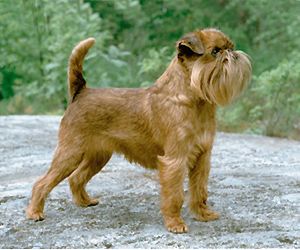Griffon Bruxellios

The Griffon Bruxellois or Brussels Griffon is named for their city of origin: Brussels, Belgium. The Griffon Bruxellois may refer to three different breeds, the Griffon Bruxellois, the Griffon Belge and the Petit Brabançon. Identical in standard except for coat and colour differences, in some standards they are considered varieties of the same breed.
The three variations of this dog, the Brussels Griffon (Griffon bruxellois), the Belgian Griffon (Griffon belge), and the Petit Brabançon, all descend from an old type (wiry coated stable dogs) and in the 19th century, they bred their Griffons with imported toy dogs. Breeding with the Pug and King Charles Spaniel brought about the current breed type, but also brought the short black coat that led to the Petits Brabançon, which was originally a fault in the breed. The spaniels also brought the rich red and black and tan colour of the modern Griffon Bruxellois and Griffon Belge of dog called a Smousje, a rough coated, small terrier-like dog kept in stables to eliminate rodents,similar to the Dutch Smoushond. The little wire-haired dog in the foreground of the Jan van Eyck painting The Arnolfini Marriage is thought to be an early form of this breed. In Belgium coachmen were fond of their alert little Griffons d’Ecurie.
The Griffon Bruxellois grew in popularity in the late 19th century with both workers and noblemen in Belgium. The first Griffon Bruxellois was registered in 1883 in the first volume Belgium's kennel club studbook, the Livre des Origines Saint-Hubert (LOSH). The popularity of the breed was increased by the interest of Queen Marie Henriette, a dog enthusiast who visited the annual dog shows in Belgium religiously, often with her daughter, and became a breeder and booster of Griffon Bruxellois, giving them international fame and popularity. Many dogs were exported to other countries, leading to Griffon Bruxellois clubs in England (1897) and Brussels Griffon clubs in the USA (1945.)
The First and the Second World War proved to be a disastrous time for the breed. War time is difficult on any dog breed, and the recovering numbers after the First World War were set back by increased vigilance in breeding away from faults such as webbed toes. By the end of the Second World War, Belgium had almost no native Griffon Bruxellois left, and it was only through the vigilance of dedicated breeders (in the U.K. particularly) that the breed survived at all.